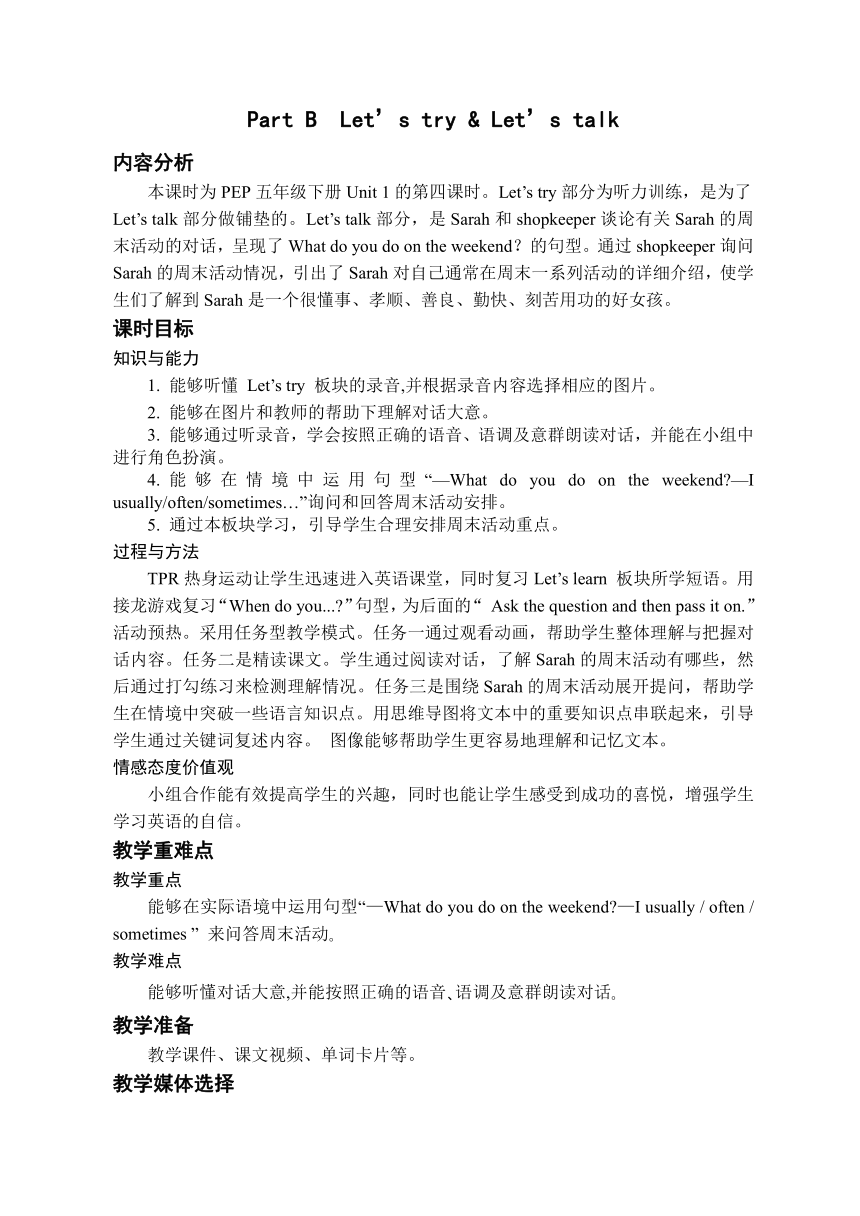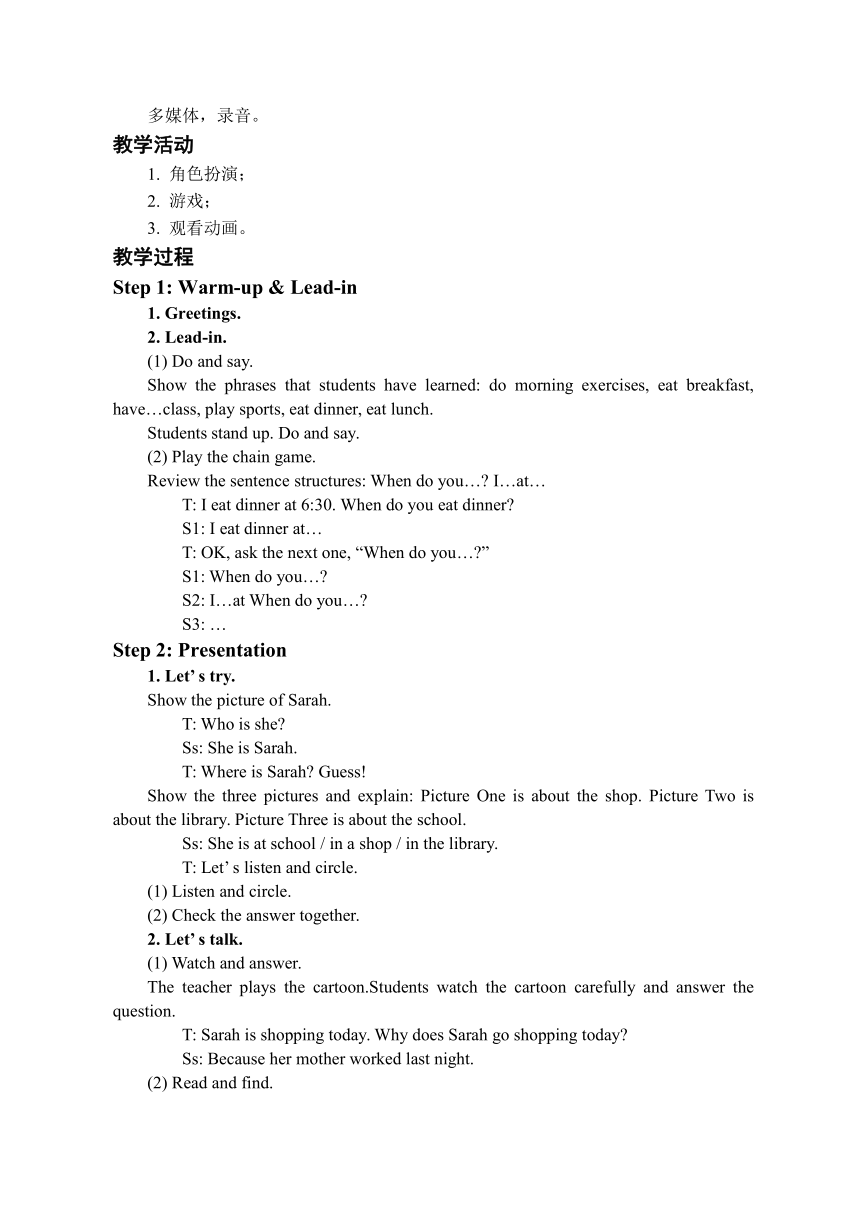Unit1 My day Part B 教案(含反思)
文档属性
| 名称 | Unit1 My day Part B 教案(含反思) |  | |
| 格式 | docx | ||
| 文件大小 | 20.3KB | ||
| 资源类型 | 教案 | ||
| 版本资源 | 人教版(PEP) | ||
| 科目 | 英语 | ||
| 更新时间 | 2022-02-28 20:09:05 | ||
图片预览


文档简介
Part B Let’s try & Let’s talk
内容分析
本课时为PEP五年级下册Unit 1的第四课时。Let’s try部分为听力训练,是为了Let’s talk部分做铺垫的。Let’s talk部分,是Sarah和shopkeeper谈论有关Sarah的周末活动的对话,呈现了What do you do on the weekend?的句型。通过shopkeeper询问Sarah的周末活动情况,引出了Sarah对自己通常在周末一系列活动的详细介绍,使学生们了解到Sarah是一个很懂事、孝顺、善良、勤快、刻苦用功的好女孩。
课时目标
知识与能力
能够听懂 Let’s try 板块的录音,并根据录音内容选择相应的图片。
能够在图片和教师的帮助下理解对话大意。
能够通过听录音,学会按照正确的语音、语调及意群朗读对话,并能在小组中进行角色扮演。
能够在情境中运用句型“—What do you do on the weekend —I usually/often/sometimes…”询问和回答周末活动安排。
通过本板块学习,引导学生合理安排周末活动重点。
过程与方法
TPR热身运动让学生迅速进入英语课堂,同时复习Let’s learn 板块所学短语。用接龙游戏复习“When do you... ”句型,为后面的“ Ask the question and then pass it on.”活动预热。采用任务型教学模式。任务一通过观看动画,帮助学生整体理解与把握对话内容。任务二是精读课文。学生通过阅读对话,了解Sarah的周末活动有哪些,然后通过打勾练习来检测理解情况。任务三是围绕Sarah的周末活动展开提问,帮助学生在情境中突破一些语言知识点。用思维导图将文本中的重要知识点串联起来,引导学生通过关键词复述内容。 图像能够帮助学生更容易地理解和记忆文本。
情感态度价值观
小组合作能有效提高学生的兴趣,同时也能让学生感受到成功的喜悦,增强学生学习英语的自信。
教学重难点
教学重点
能够在实际语境中运用句型“—What do you do on the weekend —I usually / often / sometimes ” 来问答周末活动
教学难点
能够听懂对话大意,并能按照正确的语音 语调及意群朗读对话
教学准备
教学课件、课文视频、单词卡片等。
教学媒体选择
多媒体,录音。
教学活动
角色扮演;
游戏;
观看动画。
教学过程
Step 1: Warm-up & Lead-in
1. Greetings.
2. Lead-in.
(1) Do and say.
Show the phrases that students have learned: do morning exercises, eat breakfast, have…class, play sports, eat dinner, eat lunch.
Students stand up. Do and say.
(2) Play the chain game.
Review the sentence structures: When do you… I…at…
T: I eat dinner at 6:30. When do you eat dinner
S1: I eat dinner at…
T: OK, ask the next one, “When do you… ”
S1: When do you…
S2: I…at When do you…
S3: …
Step 2: Presentation
1. Let’ s try.
Show the picture of Sarah.
T: Who is she
Ss: She is Sarah.
T: Where is Sarah Guess!
Show the three pictures and explain: Picture One is about the shop. Picture Two is about the library. Picture Three is about the school.
Ss: She is at school / in a shop / in the library.
T: Let’ s listen and circle.
(1) Listen and circle.
(2) Check the answer together.
2. Let’ s talk.
(1) Watch and answer.
The teacher plays the cartoon.Students watch the cartoon carefully and answer the question.
T: Sarah is shopping today. Why does Sarah go shopping today
Ss: Because her mother worked last night.
(2) Read and find.
T: Good! What does Sarah do on the weekend Read the text and underline the sentences.
Then let students tick the things Sarah does on the weekend. The teacher and students check the answer.
Tick the things Sarah does on the weekend.
Sarah’s weekend
Play music Watch TV √
Play ping-pong √ Wash her clothes √
Cook dinner √ Clean her room
(3) Practice sentence patterns.
①Learn “What do you do on the weekend ” and “I usually / often / sometimes…”
T: What does Sarah do on the weekend Can you read out a sentence
Ss: She said “I often watch TV and play ping-pong.”
T: Sarah often watches TV and plays ping-pong. How about you What do you do on the weekend
You can answer like this: I usually / often / sometimes…
(Write down “What do you do on the weekend ” and “ I usually / often / sometimes…” on the blackboard.)
Make a model:
T: S1, what do you do on the weekend
S1: I usually / often / sometimes…
T: Wow, that sounds like a lot of fun.
② Learn “That sounds like a lot of fun.”
The teacher listens to students’ answers carefully and evaluates with “That sounds like a lot of fun.”
(Write down “sound like a lot of fun” on the blackboard.)
T: Class, when you hear an interesting story, you can say…
Ss: That sounds like a lot of fun.
T: When your friend says “I watch TV and play ping-pong with my father”, you can say…
Ss: That sounds like a lot of fun. (Say loudly.)
③ Learn “You are so busy.”
T: Sarah has a funny weekend, but she is also hard-working. What does Sarah usually do at home Please read out the sentences.
Ss: Sarah said “I usually wash my clothes.” “Sometimes I cook dinner.”
(Write down “wash my clothes” “cook dinner” on the blackboard.)
T: Sarah is hard-working. What about you What housework can you do
(Write down “hard-working” on the blackboard.)
Ss: Clean my room. / Sweep the floor. / Do the dishes. / Water the flowers. /…
(Write down these phrases the students said on the blackboard.)
T: Wow, you are as helpful and hard-working as Sarah.
Step 3: Practice
1. Read and act.
(1) The teacher plays the cartoon of the dialogue. Students read after it. Let students pay attention to the pronunciation and the intonation.
(2) Students practise the dialogue in groups.
(3) Act out.
2. Make a new dialogue.
T: Why are you shopping today
Ss: ______. So I’ m shopping today.
T: Good ______! So what do you do on the weekend
Ss: I often ______.
T: That sounds like a lot of fun.
Ss: Yes, but I’ m also hard-working. I usually ______.
T: You are so busy! You need a robot to help you!
3. Ask the question and then pass it on.
(1) Students read the phrases in the yellow blanks.
(2) Make a model.
T: What do you do on the weekend
S1: I often / usually / sometimes .What do you do on the weekend
S2: I . What do you do on the weekend
S3: …
(3) Show time.
板书设计
Unit 1 My day
Part B Let’s try&Let’s talk
—What do you do on the weekend?
—I usually/often/sometimes watch TV.
play ping-pong.
wash my clothes.
cook dinner.
...
Sound like a lot of fun
hard-working busy need a robot
作业设计
1. Practice the dialogue.(课后和同桌两人练习今日所学的Let’s talk的对话。)
教学反思
通过从整体到局部的教学步骤,使学生在浸润式阅读中理解文本内容 从学生反馈情况来看,效果较为理想
2. 在教学过程中设计有梯度的教学任务,充分考虑学情,使学生在轻松愉快的氛围中掌握新知。
3. 利用思维导图帮助学生理解 记忆知识,培养学生的抽象思维,让他们迅速提取关键词,加深对文本的理解与记忆
内容分析
本课时为PEP五年级下册Unit 1的第四课时。Let’s try部分为听力训练,是为了Let’s talk部分做铺垫的。Let’s talk部分,是Sarah和shopkeeper谈论有关Sarah的周末活动的对话,呈现了What do you do on the weekend?的句型。通过shopkeeper询问Sarah的周末活动情况,引出了Sarah对自己通常在周末一系列活动的详细介绍,使学生们了解到Sarah是一个很懂事、孝顺、善良、勤快、刻苦用功的好女孩。
课时目标
知识与能力
能够听懂 Let’s try 板块的录音,并根据录音内容选择相应的图片。
能够在图片和教师的帮助下理解对话大意。
能够通过听录音,学会按照正确的语音、语调及意群朗读对话,并能在小组中进行角色扮演。
能够在情境中运用句型“—What do you do on the weekend —I usually/often/sometimes…”询问和回答周末活动安排。
通过本板块学习,引导学生合理安排周末活动重点。
过程与方法
TPR热身运动让学生迅速进入英语课堂,同时复习Let’s learn 板块所学短语。用接龙游戏复习“When do you... ”句型,为后面的“ Ask the question and then pass it on.”活动预热。采用任务型教学模式。任务一通过观看动画,帮助学生整体理解与把握对话内容。任务二是精读课文。学生通过阅读对话,了解Sarah的周末活动有哪些,然后通过打勾练习来检测理解情况。任务三是围绕Sarah的周末活动展开提问,帮助学生在情境中突破一些语言知识点。用思维导图将文本中的重要知识点串联起来,引导学生通过关键词复述内容。 图像能够帮助学生更容易地理解和记忆文本。
情感态度价值观
小组合作能有效提高学生的兴趣,同时也能让学生感受到成功的喜悦,增强学生学习英语的自信。
教学重难点
教学重点
能够在实际语境中运用句型“—What do you do on the weekend —I usually / often / sometimes ” 来问答周末活动
教学难点
能够听懂对话大意,并能按照正确的语音 语调及意群朗读对话
教学准备
教学课件、课文视频、单词卡片等。
教学媒体选择
多媒体,录音。
教学活动
角色扮演;
游戏;
观看动画。
教学过程
Step 1: Warm-up & Lead-in
1. Greetings.
2. Lead-in.
(1) Do and say.
Show the phrases that students have learned: do morning exercises, eat breakfast, have…class, play sports, eat dinner, eat lunch.
Students stand up. Do and say.
(2) Play the chain game.
Review the sentence structures: When do you… I…at…
T: I eat dinner at 6:30. When do you eat dinner
S1: I eat dinner at…
T: OK, ask the next one, “When do you… ”
S1: When do you…
S2: I…at When do you…
S3: …
Step 2: Presentation
1. Let’ s try.
Show the picture of Sarah.
T: Who is she
Ss: She is Sarah.
T: Where is Sarah Guess!
Show the three pictures and explain: Picture One is about the shop. Picture Two is about the library. Picture Three is about the school.
Ss: She is at school / in a shop / in the library.
T: Let’ s listen and circle.
(1) Listen and circle.
(2) Check the answer together.
2. Let’ s talk.
(1) Watch and answer.
The teacher plays the cartoon.Students watch the cartoon carefully and answer the question.
T: Sarah is shopping today. Why does Sarah go shopping today
Ss: Because her mother worked last night.
(2) Read and find.
T: Good! What does Sarah do on the weekend Read the text and underline the sentences.
Then let students tick the things Sarah does on the weekend. The teacher and students check the answer.
Tick the things Sarah does on the weekend.
Sarah’s weekend
Play music Watch TV √
Play ping-pong √ Wash her clothes √
Cook dinner √ Clean her room
(3) Practice sentence patterns.
①Learn “What do you do on the weekend ” and “I usually / often / sometimes…”
T: What does Sarah do on the weekend Can you read out a sentence
Ss: She said “I often watch TV and play ping-pong.”
T: Sarah often watches TV and plays ping-pong. How about you What do you do on the weekend
You can answer like this: I usually / often / sometimes…
(Write down “What do you do on the weekend ” and “ I usually / often / sometimes…” on the blackboard.)
Make a model:
T: S1, what do you do on the weekend
S1: I usually / often / sometimes…
T: Wow, that sounds like a lot of fun.
② Learn “That sounds like a lot of fun.”
The teacher listens to students’ answers carefully and evaluates with “That sounds like a lot of fun.”
(Write down “sound like a lot of fun” on the blackboard.)
T: Class, when you hear an interesting story, you can say…
Ss: That sounds like a lot of fun.
T: When your friend says “I watch TV and play ping-pong with my father”, you can say…
Ss: That sounds like a lot of fun. (Say loudly.)
③ Learn “You are so busy.”
T: Sarah has a funny weekend, but she is also hard-working. What does Sarah usually do at home Please read out the sentences.
Ss: Sarah said “I usually wash my clothes.” “Sometimes I cook dinner.”
(Write down “wash my clothes” “cook dinner” on the blackboard.)
T: Sarah is hard-working. What about you What housework can you do
(Write down “hard-working” on the blackboard.)
Ss: Clean my room. / Sweep the floor. / Do the dishes. / Water the flowers. /…
(Write down these phrases the students said on the blackboard.)
T: Wow, you are as helpful and hard-working as Sarah.
Step 3: Practice
1. Read and act.
(1) The teacher plays the cartoon of the dialogue. Students read after it. Let students pay attention to the pronunciation and the intonation.
(2) Students practise the dialogue in groups.
(3) Act out.
2. Make a new dialogue.
T: Why are you shopping today
Ss: ______. So I’ m shopping today.
T: Good ______! So what do you do on the weekend
Ss: I often ______.
T: That sounds like a lot of fun.
Ss: Yes, but I’ m also hard-working. I usually ______.
T: You are so busy! You need a robot to help you!
3. Ask the question and then pass it on.
(1) Students read the phrases in the yellow blanks.
(2) Make a model.
T: What do you do on the weekend
S1: I often / usually / sometimes .What do you do on the weekend
S2: I . What do you do on the weekend
S3: …
(3) Show time.
板书设计
Unit 1 My day
Part B Let’s try&Let’s talk
—What do you do on the weekend?
—I usually/often/sometimes watch TV.
play ping-pong.
wash my clothes.
cook dinner.
...
Sound like a lot of fun
hard-working busy need a robot
作业设计
1. Practice the dialogue.(课后和同桌两人练习今日所学的Let’s talk的对话。)
教学反思
通过从整体到局部的教学步骤,使学生在浸润式阅读中理解文本内容 从学生反馈情况来看,效果较为理想
2. 在教学过程中设计有梯度的教学任务,充分考虑学情,使学生在轻松愉快的氛围中掌握新知。
3. 利用思维导图帮助学生理解 记忆知识,培养学生的抽象思维,让他们迅速提取关键词,加深对文本的理解与记忆
